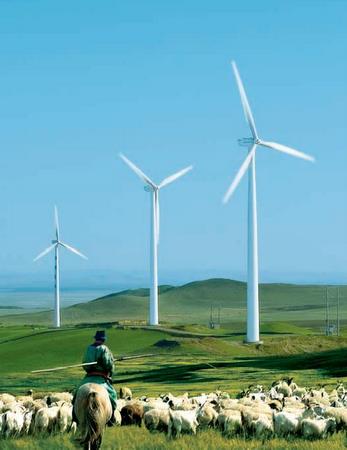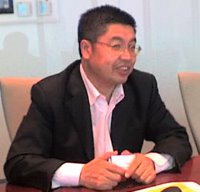
Photo: Company
CHINA WINDPOWER GROUP readily admits that strong government support for renewable forms of energy -- including wind, hydro, nuclear and solar – are helping propel growth for the Hong Kong-listed firm.
The company is also hopeful that its highly efficient mode of electricity generation as well as growing acceptance and popularity of wind power in China will reap windfall profits down the line.
In fact, evidence of this windfall is already blowing in the wind.
In the company’s most recent half-year results to end-September 2008, revenue skyrocketed to 270 mln hkd compared with 77 mln a year earlier, backed by strong demand and generation capacity increases.
Profit attributable to shareholders was 53.9 mln hkd versus 18.6 mln.
The group added three wind power plants to the electric power grid during the period and sold on-grid electricity amounting to 65.18 mln Kwh.
It also began construction of five new wind power plants with a total capacity of 248 MW in the six months, with the group’s Erlianhaote and Taipusiqi having the added bonus of receiving VAT tax rebates of 60 mln yuan.
“China’s wind industry is growing very fast, nearly doubling last year. We expect fast growth going forward,” said Mr. Luo Maofeng, Vice President (IR & International Business) of China WindPower, in an interview with NextInsight.
Despite phenomenal growth in China, its main market, the company is aggressively seeking to expand capacity in a decidedly regulatory-friendly operating environment.
And the firm was not planning to follow a single capacity development model, but would take each project proposal on a case-by-case basis.
“While we are always on the lookout for wind power assets, we are also stressing organic growth. We will still stay focused on the Chinese market,” Luo said. And this market preference for the world’s most populous nation is not without good reason.

Photo by Andrew Vanburen
Growing demand the wind in its sales
The country’s installed wind power capacity is likely to surpass 30,000 MW by end-2010, up from 12,000 MW last year, official press cited Shi Lishan, deputy director of the new energy department under the National Energy Administration (NEA), as saying last week.
In order to reach this target, China needs to pump at least an additional 100 bln yuan in the sector, said Shi.
China WindPower’s Luo said he was confident that wind power should grow faster than its more expensive renewable rivals.
“Looking forward to 2020, I see wind growing faster than solar power. Wind power has a higher efficiency rate than solar and hydropower,” Luo said.
He predicted that by 2020, at least 8% of China’s energy needs will be met by wind power. Wind currently accounts for just 2% of China’s electricity generation, leaving a tremendous potential for future growth at the expense of other forms of energy production.
The company’s turbine equipment is all manufactured domestically, but still depends on foreign designs (mainly German). It is entirely self-reliant in the production of other supporting equipment for wind generation plants and the infrastructure necessary to hook them up to power grids.
“Our equipment is all self-made (except for turbines), so it’s a strategic advantage for us. Also, while the average life span for other producers’ equipment is 7-10 years, ours is 20 years,” Luo added.
He said that the company’s equipment and the turbines it turns out with foreign designs are destined for use within China, due not only to overwhelmingly demand here, but also specification differentials.
“The US and EU mainly use slightly higher generating-capacity equipment than ours.” China WindPower said it is pushing ahead with the Clean Development Mechanism (CDM) registration procedure for new wind power plant projects, some of which have gained state approval already.
The group filed applications with the UN Framework Convention on Climate Change for these projects and expects to receive approval for them “in the near future,” the company said.
CDM is an arrangement under the Kyoto Protocol allowing industrialized countries with a greenhouse gas reduction commitment (called Annex B countries) to invest in projects that reduce emissions in developing countries as an alternative to more expensive emission reductions in their own countries.
In terms of installed wind power capacity, China currently ranks fourth globally, and the sector here has seen over 100% annual growth over the past few years, and among all the clean energy sources, wind is developing the fastest.
“The 30,000 MW target is achievable given the fast pace of growth," the NEA’s Shi said in the official media report.
And by 2020, China should have wind power capacity of 100,000 MW, accounting for around 10% of the country's total power generation capacity, Shi said, which means wind power will likely surpass nuclear power at that time as China's third-largest source of electricity, after thermal and hydropower.
As the world's second largest energy consumer, China has devised preferential policies to boost the development of wind energy.
Currently, the country is charting a development plan for the new energy industry, which will reportedly involve an investment of 3 trln yuan.
"There is no doubt that wind power will account for an important part of that blueprint, as it is now the most developed sector in the new energy area," said Shi.
Wind power has three distinctive advantages. It is renewable, little water consuming and emission-free. Development of wind power can help China achieve its environment protection and emission control targets, he said. Wind power is "vital" as it is the cheapest form of renewable energy, Shi said.
And China Windpower’s Luo was confident the company was not tipping at windmills with its push to play a more dominant role in China’s drive toward sustainable, non-polluting energy generation to fuel its ravenous economy.
“Carbon credits are also a major potential revenue earner for us,” Luo said.
See also:
ANWELL: Getting ready to launch solar panel production
ANWELL shareholders keen to know about its new solar venture



